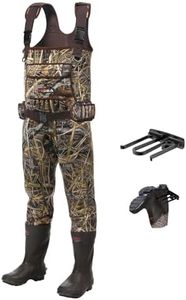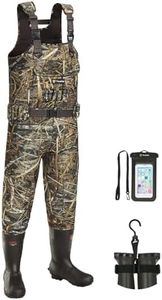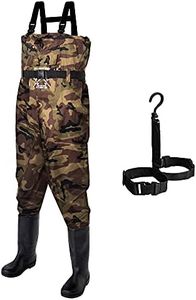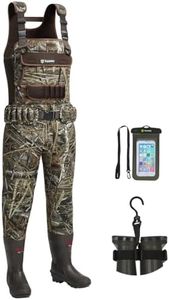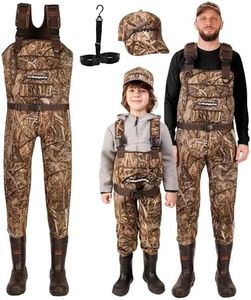We Use CookiesWe use cookies to enhance the security, performance,
functionality and for analytical and promotional activities. By continuing to browse this site you
are agreeing to our privacy policy
10 Best Neoprene Chest Waders
From leading brands and best sellers available on the web.Buying Guide for the Best Neoprene Chest Waders
Choosing neoprene chest waders can make your experience with fishing, hunting, or working in wet environments much more comfortable and efficient. The right pair of waders will keep you dry, regulate warmth, and provide flexibility based on your activity. To find the best fit, you should consider how often you’ll use them, the temperatures you’ll face, and what type of movement or terrain is involved. Understanding the key specifications below will help you match a wader to your needs.Neoprene ThicknessNeoprene thickness determines how warm and insulated your waders will be. Common values are 3mm, 5mm, and sometimes 7mm. Thinner options like 3mm are lighter and better for mild weather and more active movement but provide less insulation against cold. Thicker neoprene, like 5mm or more, offers more warmth for colder environments but can be heavier and less flexible. You should pick the thickness according to the water and air temperatures you expect, with thicker options for cold water or late-season use, and thinner for mild climates or highly mobile activities.
Boot Style (Bootfoot vs. Stockingfoot)Waders come either with boots attached (bootfoot) or with neoprene socks at the bottom (stockingfoot), which require separate wading boots. Bootfoot waders are convenient and quick to put on because the boot is part of the wader, which is great for situations where you want simplicity and don’t need premium traction or ankle support. Stockingfoot waders, needing separate boots, allow for better fit, replaceable boots, and better grip on slippery surfaces. Choose bootfoot for convenience and low-intensity work, and stockingfoot if you prioritize flexibility and will be walking in rough or slippery terrain.
Fit and SizeProper fit ensures comfort and effectiveness. Waders come in different sizes for height, chest, and inseam. Too loose and they’ll be bulky and heavy with water; too tight and they restrict movement and may stress the material. You should measure yourself and consult the sizing chart for the wader brand, considering what you’ll wear underneath, like extra layers in cold weather. Always prioritize a comfortable fit across your chest and waist, with enough room for bending and stepping.
Seam ConstructionThe way seams are put together affects waterproofness and durability. Most neoprene waders have glued, stitched, and sometimes taped seams to prevent leaks. More reinforced seams mean better long-term durability, especially when moving through brush or kneeling frequently. If you expect to use your waders in rougher environments or for multiple seasons, look for multiple forms of seam reinforcement.
Pockets and StorageChest waders often have pockets for storing tools, flies, or warming your hands. Some have waterproof or fleece-lined pockets, while others have basic pouches. Think about what you need quick access to and whether you’ll need to keep items dry. Choose waders with appropriate pocket options if you want convenience or regularly carry gear.
Suspenders and BeltsSuspenders hold up the waders and are usually adjustable for comfort and fit. Some have quick-release buckles for easy on and off. A wading belt helps cinch the waders around your waist for safety, keeping water from filling the wader if you fall. Make sure the suspenders adjust easily and the belt feels secure, especially if you’ll be in fast-moving water or want extra support.


